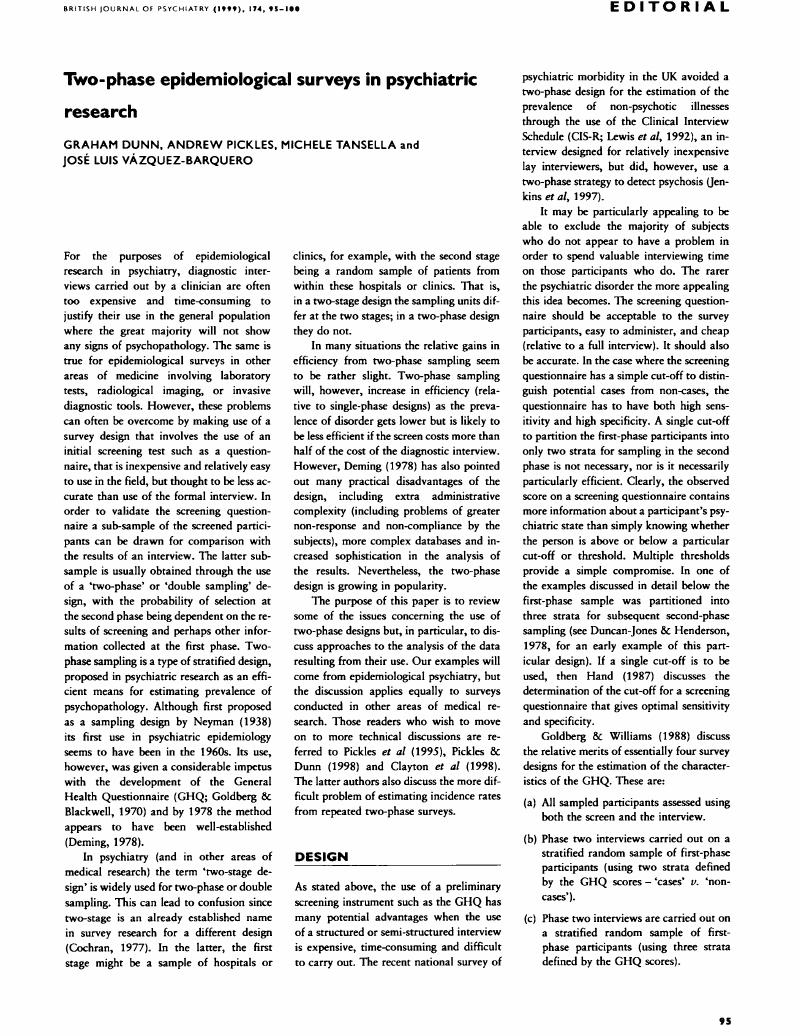Crossref Citations
This article has been cited by the following publications. This list is generated based on data provided by Crossref.
Patton, G. C.
Coffey, C.
Posterino, M.
Carlin, J. B.
and
Wolfe, R.
2000.
Adolescent Depressive Disorder: A Population-Based Study of ICD-10 Symptoms.
Australian & New Zealand Journal of Psychiatry,
Vol. 34,
Issue. 5,
p.
741.
Lasa, L
Ayuso-Mateos, J.L
Vázquez-Barquero, J.L
Dı́ez-Manrique, F.J
and
Dowrick, C.F
2000.
The use of the Beck Depression Inventory to screen for depression in the general population: a preliminary analysis.
Journal of Affective Disorders,
Vol. 57,
Issue. 1-3,
p.
261.
Ruggeri, Mirella
Leese, Morven
Thornicroft, Graham
Bisoffi, Giulia
and
Tansella, Michele
2000.
Definition and prevalence of severe and persistent mental illness.
British Journal of Psychiatry,
Vol. 177,
Issue. 2,
p.
149.
Patton, G. C.
Coffey, C.
Posterino, M.
Carlin, J. B.
and
Wolfe, R.
2000.
Adolescent Depressive Disorder: A Population-Based Study of ICD-10 Symptoms.
Australian & New Zealand Journal of Psychiatry,
Vol. 34,
Issue. 5,
p.
741.
Bisoffi, Giulia
Mazzi, Maria Angela
and
Dunn, Graham
2000.
Evaluating screening questionnaires using receiver Operating Characteristic (ROC) curves from two‐phase (double) samples.
International Journal of Methods in Psychiatric Research,
Vol. 9,
Issue. 3,
p.
121.
Ayuso-Mateos, Jose Luis
Vázquez-Barquero, Jose Luis
Dowrick, Christopher
Lehtinen, Ville
Dalgard, Odd Steffen
Casey, Patricia
Wilkinson, Clare
Lasa, Lourdes
Page, Helen
Dunn, Graham
and
Wilkinson, Greg
2001.
Depressive disorders in Europe: prevalence figures from the ODIN study.
British Journal of Psychiatry,
Vol. 179,
Issue. 4,
p.
308.
Davison, Sophie
Leese, Morven
and
Taylor, Pamela J.
2001.
Examination of the Screening Properties of the Personality Diagnostic Questionnaire 4+(PDQ-4+) in a Prison Population.
Journal of Personality Disorders,
Vol. 15,
Issue. 2,
p.
180.
Hansen, Morten Steen
Fink, Per
Frydenberg, Morten
de Jonge, Peter
and
Huyse, Frits J
2001.
Complexity of care and mental illness in medical inpatients.
General Hospital Psychiatry,
Vol. 23,
Issue. 6,
p.
319.
Hansen, Morten Steen
Fink, Per
Frydenberg, Morten
Oxhøj, Marie-Louise
Søndergaard, Lene
and
Eriksen, Mette
2001.
Mental Disorders in Medical Inpatients and the Association to Severity of Illness, Self-Rated Physical Disability, and Health Perception.
Psychosomatics,
Vol. 42,
Issue. 1,
p.
41.
Hill, Jonathan
Pickles, Andrew
Burnside, Elizabeth
Byatt, Marie
Rollinson, Lynn
Davis, Rachel
and
Harvey, Katie
2001.
Child sexual abuse, poor parental care and adult depression: evidence for different mechanisms.
British Journal of Psychiatry,
Vol. 179,
Issue. 2,
p.
104.
Hansen, Morten Steen
Fink, Per
Frydenberg, Morten
Oxhøj, Marie-Louise
Søndergaard, Lene
and
Munk-Jørgensen, Povl
2001.
Mental disorders among internal medical inpatients.
Journal of Psychosomatic Research,
Vol. 50,
Issue. 4,
p.
199.
Balestrieri, Matteo
Bisoffi, Giulia
Tansella, Michele
Martucci, Marilena
and
Goldberg, David P.
2002.
Identification of depression by medical and surgical general hospital physicians.
General Hospital Psychiatry,
Vol. 24,
Issue. 1,
p.
4.
Angst, Jules
Gamma, Alex
Sellaro, Robert
Zhang, Heping
and
Merikangas, Kathleen
2002.
Toward validation of atypical depression in the community: results of the Zurich cohort study.
Journal of Affective Disorders,
Vol. 72,
Issue. 2,
p.
125.
Hansen, Morten Steen
Fink, Per
Frydenberg, Morten
and
Oxhøj, Marie-Louise
2002.
Use of Health Services, Mental Illness, and Self-Rated Disability and Health in Medical Inpatients.
Psychosomatic Medicine,
Vol. 64,
Issue. 4,
p.
668.
Mcconnell, Pamela
Bebbington, Paul
Mcclelland, Roy
Gillespie, Kate
and
Houghton, Sharon
2002.
Prevalence of psychiatric disorder and the need for psychiatric care in Northern Ireland.
British Journal of Psychiatry,
Vol. 181,
Issue. 3,
p.
214.
Wing, Yun‐Kwok
Li, Raymond Hiu‐Yeung
Lam, Ching‐Wan
Ho, Crover Kwok‐Wah
Fong, Samson Yuk‐Yat
and
Leung, Tony
2002.
The prevalence of narcolepsy among Chinese in Hong Kong.
Annals of Neurology,
Vol. 51,
Issue. 5,
p.
578.
Kaaya, S. F.
Fawzi, M. C. S.
Mbwambo, J. K.
Lee, B.
Msamanga, G. I.
and
Fawzi, W.
2002.
Validity of the Hopkins Symptom Checklist‐25 amongst HIV‐positive pregnant women in Tanzania.
Acta Psychiatrica Scandinavica,
Vol. 106,
Issue. 1,
p.
9.
Becker, Susan
Al Zaid, Khalid
and
Al Faris, Eiad
2002.
Screening for Somatization and Depression in Saudi Arabia: A Validation Study of the Phq in Primary Care.
The International Journal of Psychiatry in Medicine,
Vol. 32,
Issue. 3,
p.
271.
Merikangas, Kathleen Ries
Avenevoli, Shelli
Acharyya, Suddhasatta
Zhang, Heping
and
Angst, Jules
2002.
The spectrum of social phobia in the zurich cohort study of young adults.
Biological Psychiatry,
Vol. 51,
Issue. 1,
p.
81.
AL-ADAWI, SAMIR
DORVLO, ATSU S.S.
BURKE, DAVID T.
AL-BAHLANI, SABAH
MARTIN, RODGER G.
and
AL-ISMAILY, SALEM
2002.
Presence and Severity of Anorexia and Bulimia Among Male and Female Omani and Non-Omani Adolescents.
Journal of the American Academy of Child & Adolescent Psychiatry,
Vol. 41,
Issue. 9,
p.
1124.






eLetters
No eLetters have been published for this article.